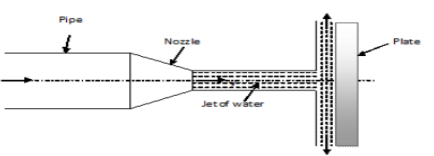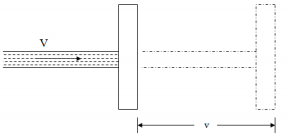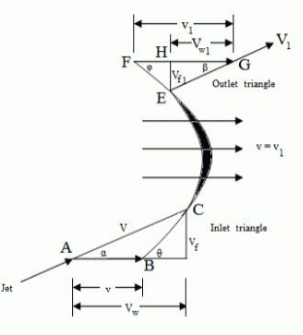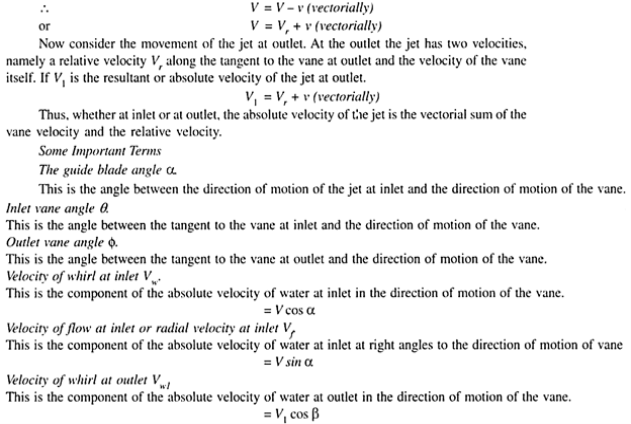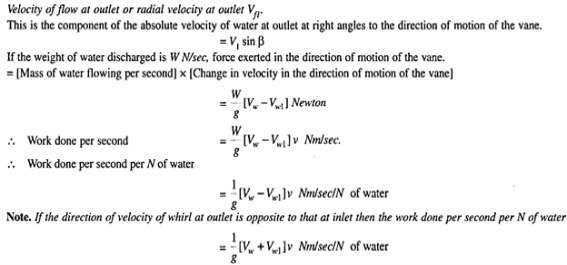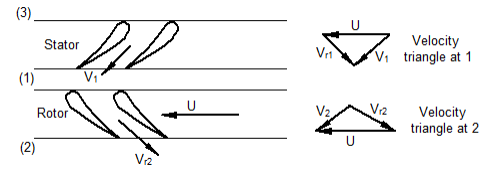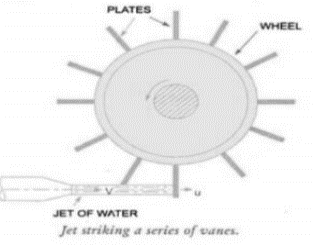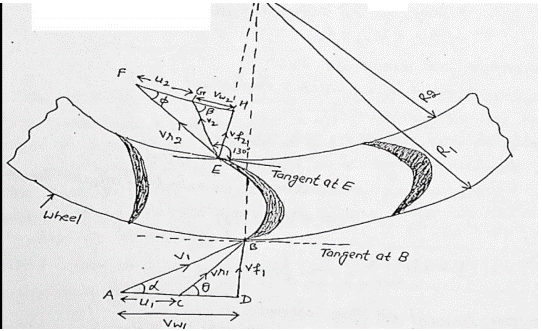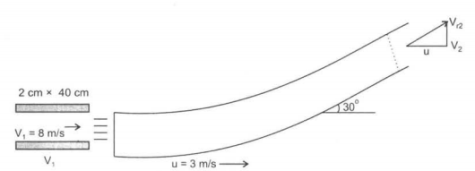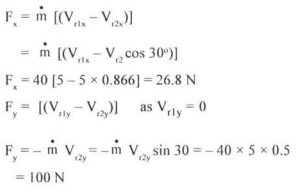the whole system,
If we define momentum by I˘=mVˉ, then
|
|
[Fluid mass within section 1-1 and 1’-1’] = [Fluid mass within section 2-2 and 2’-2’] M (11′1′1) = M (22′2′2) The momentum of the system at time t,
The momentum of the system at time t+dt,
Change of momentum at dt time,
Furthermore, when the flow is steady,
From the Last two equations
From previous equations,
|
|
Let, • Ɵ = Angle at which the plate is inclined with the jet Force exerted by the jet on the plane = waV2/g KN Force exerted by the jet in a direction normal to the plate, F= waV2sin Ɵ/g and the force exerted by the jet in the direction of flow,
Similarly, the force exerted by the jet in a direction normal to flow,
|
|
|
|
|
|
 The velocity triangles at the inlet and outlet of the rotor are of utmost importance in deciding the size of the turbomachine for the given power output. Q8) Describe the impact of jet on series of flat plates Mounted on a wheel.A8) The configuration of the system is shown in fig,. In this case, the plate fixed on the wheel moves with a velocity u in the direction of the jet. As one plate comes out of the jet, the jet strikes on the other plate, and the whole flow from the jet strikes the plate when all plates are considered.
The velocity triangles at the inlet and outlet of the rotor are of utmost importance in deciding the size of the turbomachine for the given power output. Q8) Describe the impact of jet on series of flat plates Mounted on a wheel.A8) The configuration of the system is shown in fig,. In this case, the plate fixed on the wheel moves with a velocity u in the direction of the jet. As one plate comes out of the jet, the jet strikes on the other plate, and the whole flow from the jet strikes the plate when all plates are considered.
|
The velocity of the jet with which jet strikes the plate is the relative velocity of the jet which is (V-u) The final velocity of the jet after striking the plate = V-u =0. Change in velocity = initial relative velocity – Final relative velocity = (V-u) – 0= V-u Force acting on the plate = 𝑚̇ 𝑥 𝐶ℎ𝑎𝑛𝑔𝑒̇ 𝑖𝑛 𝑣𝑒𝑙𝑜𝑐𝑖𝑡𝑦 = 𝜌𝑎𝑉(𝑉 − 𝑢) Newtons The efficiency of the system is given by 𝜂 = 𝑂𝑢𝑡𝑝𝑢𝑡 /𝐼𝑛𝑝𝑢𝑡 = 𝐹 𝑥 𝑢 /(1/2)𝑚𝑉2 = 𝜌𝑎𝑉(𝑉−𝑢)𝑢 /(1/2) 𝜌𝑎𝑉𝑉2 𝜂 = 2(𝑉−𝑢)𝑢 /𝑉2 For finding out the maximum velocity for the given input (V is constant), The condition required is, 𝑑𝜂/𝑑𝑢 = 0 𝑑/𝑑𝑢 [𝑢(𝑉 − 𝑢)] = 0 V- 2u = 0 u = 𝑉/2 Corresponding maximum efficiency is given by 𝜂𝑚𝑎𝑥 = 2 (2𝑢−𝑢)𝑥 𝑢 /(2𝑉)2 = 0.5 𝜂𝑚𝑎𝑥 = 50%
|
|
Let, 𝜔 = angular speed of the wheel R1, R2 = Radii of the wheel at inlet and outlet of vane respectively As vane are situated radially around the wheel blade velocities at inlet and outlet tip of vane would be different u1 = 𝜔 R1 and u2 = 𝜔 R2 The flow system is inward or outward depending upon whether the jet enters the outer periphery or the inner periphery. The mass of water striking/sec = mass of water issuing from the nozzle per second = 𝜌aV1 The momentum of water striking the vanes (in tangential direction) per second at the inlet = 𝜌aV1 x Vw1 Similarly Momentum of water striking the vanes (in tangential direction) per second at the outlet = 𝜌aV1 x (- Vw2) = - 𝜌aV1 x Vw2 -ve sign is taken as V2 at the outlet is in opposite direction. Now, angular momentum per second at inlet = momentum at inlet x radius at inlet = 𝜌aV1 x Vw1 x R1 angular momentum per second at outlet = 𝜌aV1 x Vw2 x R2
Torque exerted by water on the wheel, T = rate of change of angular momentum = (initial angular momentum/sec - final angular momentum/sec) = 𝜌aV1 x Vw1 x R1 – (-𝜌aV1 x Vw2 x R2) = 𝜌aV1 (Vw1 x R1 + Vw2 x R2) W.D./sec on the wheel = T x 𝜔 = 𝜌aV1 (Vw1 x R1 + Vw2 x R2) x 𝜔 = 𝜌aV1 (Vw1 x 𝜔 R1 + Vw2 x 𝜔 R2) = 𝜌aV1 (Vw1 x u1 + Vw2 x u2) In case β is an obtuse angle, then W.D./sec = 𝜌aV1 (Vw1 x u1 - Vw2 x u2) If discharge is radial at outlet, then β = 900 W.D./sec = 𝜌aV1 (Vw1 x u1) (Vw2 = 0) Efficiency of radial curved vane η = 𝑊.𝐷./ 𝑠𝑒𝑐 𝐾.𝐸./𝑠𝑒𝑐 = 𝜌aV1 (Vw1 x u1 ± Vw2 x u2)/ 𝟏/𝟐 𝜌aV3 = 2 (Vw1 x u1 ± Vw2 x u2) 𝑉2 |
Solution: (a) With reference to the Fig. given quantities are: VI = 36 m/s; Vr2=0.85Vr1; u = 15 m/s; d=IOOmm α1= 30°, α2= 90° To determine the inlet angle β1 consider the inlet velocity triangle ABD. The velocity of the fluid relative to the vane at the inlet in Vrl must be tangential to the vane and make an angle βI with the direction of motion
To determine outlet angle β2 as V2 has no component in the direction of motion, outlet angle β2 is given by
(b) Since the jet strikes series of vanes perhaps mounted on the periphery of a wheel so that each vane moves on its place is taken by the next in the series, the average length of the jet does not alter and the whole flow from the nozzle of diameter d is deflected by the vanes. The mass flow rate of the fluid from the nozzle
Velocity component of VI in direction of X = VI cos αl
Force on the direction of motion
|
|
Inlet triangle of velocity is a straight line as shown in Fig. (a). The outlet triangle of velocity is shown in Fig. (b).
Bernoulli's equation can be used to show that the velocity of the sheet VrI = Vr2 = 5 m/s as observed from the deflector. Mass flow rate is calculated on velocity VrI = 5 m/s
Force in the x-direction Fx = Mass flow rate x change of velocity
|











